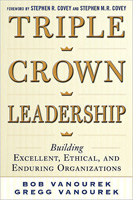Bob Vanourek and Gregg Vanourek. Triple Crown Leadership: Building Excellent, Ethical, and Enduring Organizations. New York: McGraw-Hill, 2012.
 Drawing from interviews with CEOs of sixty-one major corporations and organizations, this former CEO (Bob) and academic/entrepreneur (Gregg) have distilled five practices to generate excellent, ethical and enduring (the triple crown) organizations. These are:
Drawing from interviews with CEOs of sixty-one major corporations and organizations, this former CEO (Bob) and academic/entrepreneur (Gregg) have distilled five practices to generate excellent, ethical and enduring (the triple crown) organizations. These are:
• Head and Heart: Most organizations focus on knowledge, skills, and experience – head issues. Triple crown leader add character, emotional intelligence, and “fit” with the culture of the organization – both head and heart.
• The Colors: These leaders leverage the purpose, values and vision to represent their efforts. The reference to the colors is to those by horses and jockeys, the linking metaphor for this book.
• Continuing the horse race metaphor, Steel and Velvet: The leader’s judgment to flex between the hard and soft edges of leadership, depending on the situation, the context.
• Stewards: By working on the enterprise, not just in it, these individuals develop and protect the organization’s colors and culture.
• Alignment: leaders align organizations to achieve peak performance.
In the second half of the book the authors apply these perspectives to a variety of organizational challenges from start ups to turnarounds and having a positive social impact on all stakeholders and the environment while maintaining exceptional performance.
Theirs is another call to address the many challenges facing us in the world, socially, politically and ecologically. They conclude:
• “We need better leadership if we are to address the challenges of our age.” And we need to be clearer about what constitutes leadership. Many of the pieces are to be found in this book.
• “People can achieve incredible feats when they commit their hearts and work together toward a common purpose they believe in.” And herein lies one of the crises of our times. We are so divided in this world as to what such a common purpose might be. We continue down the path of destruction, while individuals and groups grasp for hope and resurrection.
• “We do not have to accept yesterday’s methods.” Yes and no. To some extent we need to integrate yesterday’s methods with innovation, for many people do not have the ability to see beyond yesterday’s methods. But, then, the critical mass idea may be where it’s at.
• “We need not choose between excellent, ethical, and enduring: with a certain kind of leadership, we can foster all three in ways that reinforce each other.”
I hope books like this make a difference. None of us are there, yet, but here we have further evidence that there are people in positions of influence who are insisting that we redress the tragedies of government-business collaboration and the no-man’s land of globalization.
